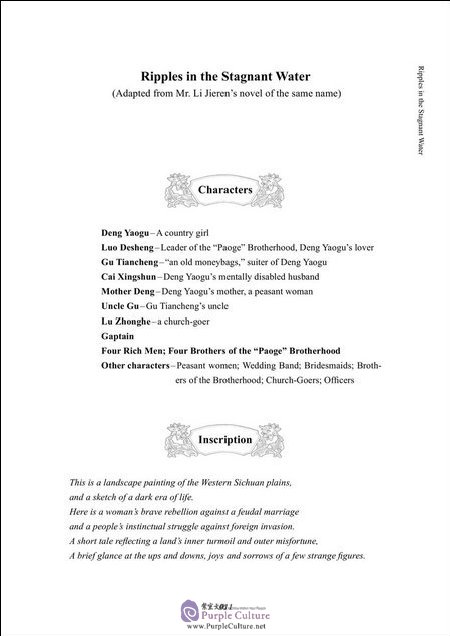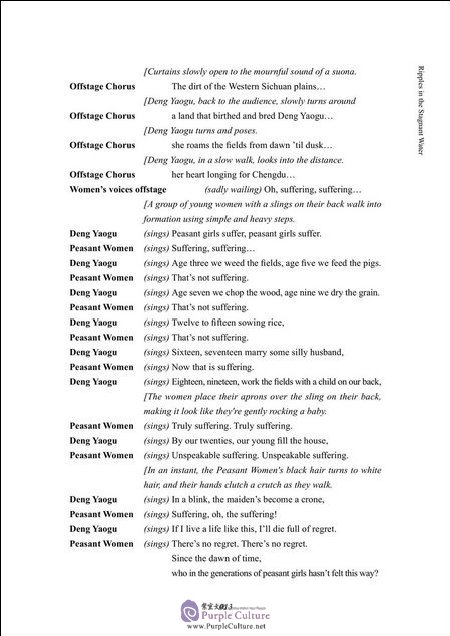

川剧简介
一、川剧和中国戏曲
川剧,是中国戏曲的一种。戏曲,是唯有中国才有的一种戏剧样式。戏曲成型于元代,1240年就被称作“戏曲”,至今已有七百多年。
中国地域宽广。因地方语言和民间音乐的差异,先先后后形成了三百六十多种“地方戏曲”。这些地方戏曲用自己所在的地名命名,比如,北京的戏曲叫“京剧”,四川的戏曲叫“川剧”。川剧是戏曲中的古老剧种,已有二百八十多年历史。
虽然语言和音乐不同,但各个地方戏曲都是由剧本文学、声乐与器乐、说唱艺术和舞蹈、美术、武术、杂技等综合而成。这种高度的综合性构成了中国戏曲的艺术特点。各个地方戏曲都是在这种艺术特点中,去展现其不同的地域个性。
由于戏曲中音乐的分量很重,西方人便用“歌剧”这个词语来称呼“戏曲”。把京剧叫作“北京歌剧”,把川剧叫作“四川歌剧”。其实,“中国戏曲”和“西方歌剧”是两种完全不同的艺术。
A Brief Introduction to Sichuan Opera
1. Sichuan Opera and Chinese Opera
Sichuan Opera (chuanju) is a type of Chinese Opera (xiqu), a style of theatrical performance unique to China. Chinese Opera was formed in the Yuan Dynasty; in 1240 these “melodic (qu) plays (xi)” were first designated, giving the form a history of over 700 years.
China’s territory is vast. Because of the differences in regional dialect and folk music styles, over 360 different kinds of “regional Chinese Operas” (difang xi) have formed. These regional Chinese Opera styles are named after their place of origin; for example, Beijing’s Chinese Opera style is called “Beijing Opera” ( jingju), Sichuan’s Chinese Opera is called “Sichuan Opera” (chuanju). Sichuan Opera is one of Chinese Opera’s ancient forms, with over 280 years of history.
Despite differences in dialect and music, each of the regional Chinese Opera forms is a composite art form, similarly consisting of dramatic literature, orchestra and percussion, vocal work and dance, aesthetics, martial arts, acrobatics and more. This high degree of comprehensiveness is one of the Chinese Opera art form’s special characteristics. On the foundation of this key characteristic, each regional Chinese Opera form has developed its own geographic personality.
Because of the importance of music in Chinese Opera, Westerners have used the term “opera” (in Chinese: geju, ge –musical, ju –theatre) to translate “Chinese Opera” (in Chinese: xiqu, xi – plays, qu – melodic), making “jingju”( jing from “Beijing,” ju – theatre) into Beijing Opera and chuanju (chuan from “Sichuan,” again, ju – theatre) into Sichuan Opera. However, what is called “Chinese Opera” and what is understood by “Western Opera” are two different art forms.
中国戏曲是一种高度综合的民族艺术。唱、念、做、打、舞在演员身上的有机构成,是戏曲综合性最集中、最突出的体现。唱,指演唱;念,指朗诵和对话;做,指形体和表情;打,指打仗、格斗等动作;舞,指表现人物情绪或戏剧场面的舞蹈。戏曲以唱、念、做、打、舞的综合表演为手段,呈现为一种形式感极强的戏剧。川剧也是这样一种形式感极强的戏剧。
二、戏曲(川剧)的虚拟性、程式性、写意性
戏曲舞台是一个基本不用布景装置的舞台。戏剧环境的确立,是以人物的活动为依据。人物上场表演了,舞台上就有了戏剧环境;人物下场之后,舞台就是一个抽象的空间。比如,一个人上场,说自己进城了,那么舞台上就是城市。然后他说要出城过河,这时他从舞台一边走到舞台另一边,那么舞台上的环境就从城里变成了河边。这时,有个船夫划着桨上场了,那么舞台上的环境就是河边来了一条小船。这人做一个跳上船的动作,船夫再用形体动作表示划船,那么舞台上的环境就是一条船行驶在河流中。从以上的描述可以看出,戏曲艺术的重要特征是非物质的虚拟性。它通过演员的动作和台词,来表现舞台上的时间和空间,以及舞台时空的转换。川剧和所有的
Chinese Opera is a kind of highly composite folk art. Through the organic composition (via actor’s body) of “singing” (chang), “reading” (nian), “doing” (zuo), “fighting” (da), and “dance” (wu), Chinese Opera’s composite nature is most comprehensively and prominently reflected. “Singing” refers to the actor’s singing; “reading” refers to recitation; “doing” refers to physicality and expression; “fighting” refers to battle and combat actions; “dance” refers to performance of a character’s emotions or dance within the drama’s scenes. Through a combination of the means “singing, reading, doing, fighting, and dance,” Chinese Opera is presented as a strongly form-based drama; thus, Sichuan Opera should also be considered a strongly form-based drama.
2. Chinese Opera (and Sichuan Opera/chuanju) and its mime, codification, and “freehand” aesthetic
The Chinese Opera stage is one that for the most part does not use scenic backgrounds. The establishment of the theatrical environment is done through the activities of the characters. When the characters are on stage performing, the stage will have a scenic environment; after the characters exit the stage, the stage is simply an abstract space. For example, a person enters the stage, says he is coming into the city; thus, the city is on the stage. Afterwards, he says he wants to leave the city and cross a river. At this point, he moves from one side of the stage to the other; now the environment onstage has changed to a riverside. At this point, a boatman rowing an oar enters; now the environment onstage is a riverside where a small boat has arrived. The man makes a jumping motion as if jumping on to the boat, and the boat man begins to use movements indicating rowing again; now the environment onstage is that of a boat moving down a flowing river. From the above description you can see one of the most important features of Chinese Opera is its non -material based mime. Through the performer.s movements and text, the time and space of the stage is expressed, as well as the transformation of said time and space. Sichuan Opera and all other regional Chinese Opera forms all use this
地方戏曲一样,都是这种演出方式。最近几十年,戏曲舞台开始有了布景装置。但这些布景装置,都力求不影响演员表演的虚拟性。
虚拟性的戏曲表演动作,当然与生活中的动作不同。比如前面说的走路、上船、划船等动作,都必须合乎戏曲的程式。程式,就是把生活中的动作提炼、概括、美化而形成比较夸张的、有舞蹈意味的规范。戏曲演员在舞台上表演关门、上楼、开窗、骑马、划船、走路、打仗、行军等生活动作,包括每个人物的一举一动、一颦一笑,都有固定的程式。这些程式是戏曲演员必须遵守的表演法则,是戏曲演员的基本功,就像芭蕾舞的脚尖、托举和跳跃一样,每个戏曲演员都要接受严格的基本功训练。没有程式的基本功,演员无法表演戏曲。程式基本功的好坏,决定戏曲演员的艺术水平。
戏曲表演的程式虽然是固定的、规范的,但也要与生活的真实感相结合。比如,在划船的程式动作中,船是虚的,但桨是实在的。在骑马的程式动作中,马是虚的,但马鞭是实在的;演员划船、挥鞭或者在船上、在马背上的状态,都必须符合戏曲的程式,同时也必须符合人们的生活感受。程式动作通过演员的形体和表情体现,这种体现就叫“身段”。
戏曲有“三五步行遍天下”的说法。当戏曲中的人物用台词说明他要去的地方,同时从舞台的一侧走到另一侧时,他就已经到了目的地。不管他走
kind of performance style. In recent decades, Chinese Opera stages have begun to use scenic elements. However, these scenic elements all strive to not affect the performer’s mimed performance.
Mimed actions within Chinese Opera performance of course are different from everyday actions. For example, in the description above, the actions of walking, boarding the boat, rowing, etc., all must adhere to the codification of Chinese Opera. Codification, then, is the process of taking everyday actions and refining them, generalizing them, aestheticizing as well as forming them to have a more exaggerated, dancelike specification. Chinese Opera performers, when performing daily actions on stage such as closing a door, ascending a staircase, opening a window, riding a horse, rowing a boat, walking, fighting, marching – every move of a character, their every facial expression – all use a fixed codification for said actions. This codification is a performance rule every Chinese Opera artist must obey; it is the “basic skill set” of a Chinese Opera performer, just as a ballet dancer must have strong toes, good lift, and solid jumps, and every performer must receive strict “basic skill set” training. Those performers without this “basic skill set” cannot perform Chinese Opera. Whether one.s “basic skill set” is strong or weak will determine a Chinese Opera performer.s artistic quality.
Although the codification of Chinese Opera performance is fixed and standardized, it does want to be combined with everyday realism. For example, as one is performing the codified action of rowing a boat, the boat is mimed but the oar is real. When performing the codified action of riding a horse, the horse is mimed but the horsewhip is real; the attitude of the performer rowing the boat or whipping the whip, atop the boat or on horseback must adhere to the codification of Chinese Opera but at the same time must also adhere to one.s feelings in everyday life. Through the actor.s body and facial expression, codified actions come to be called
“physicality” (shenduan).
Chinese Opera has an expression that reads “three steps, five steps to walk all across the world.” When a character in a Chinese Opera piece uses text to indicate that he is going somewhere, and at the same time moves from one side of the stage
了几个月,走了多少里,是坐船还是骑马,反正他在舞台上转个圈,说自己到了,就到了。这样的表现手法叫作“圆场”。
戏曲演出中有些情节,演员不必表演但又必须交代。比如要打仗了,将军在台上发出口令,就有士兵执兵器上场。士兵们走过舞台就下场,表示队伍已经出发了,这样的表演方式就叫“过场”。也有另一类情况。比如,一个姑娘急着换上漂亮衣服去见情人,表演者就要组织许多程式动作,让观众欣赏她的喜悦、激动和慌张,看她着急得甚至把衣服穿反了。这一类纯粹的戏剧性程式动作,剧本很难用文字表达,于是用“身段过场”提示一下就行了。
如上所言,当舞台呈现以虚拟取代了真实,当生活动作已形成规范化的程式,戏曲的表演艺术必然和生活的自然形态拉开了距离。于是,戏曲艺术的美学核心就是“写意”。写意的虚拟性、程式性,以及由此而来的节奏性、歌舞性等,就成了戏曲的方法体系和艺术特色。写意,使戏曲舞台的时空有了“弹性”:时间的长短、空间的变迁,完全由演员用动作和台词来决定。写意,使程式化的“圆场”“过场”“身段”“身段过场”等表演方式,成为戏曲的作家、演员、观众三者之间的默契。
虚拟性、程式性、写意性,决定了戏曲之所以成为戏曲,自然也决定了川剧之所以成为川剧。
to the other, he has already reached his destination. It doesn.t matter if he.s been traveling several months or several miles, by boat or on horseback, when he circles the stage and says that he.s arrived, he is there. This manner of expression is called “circling the stage” (yuanchang).
Within the scenes of a play, some things are not necessary for actors to perform but must be accounted for; for example, if a battle is necessary, a general only needs to call out and soldiers will run on with weapons. As they enter, cross the stage, and exit again, this indicates that that troops have set out. This type of expression is referred to as “crossing the stage” (guochang). Another such situation is as follows: if a girl is rushing to change into beautiful garments to meet a lover, the performer will employ many codified to do this, making the audience appreciate her joy, excitement, and nervousness, seeing her even putting her clothing on backwards. This kind of purely theatrical codified movement is difficult to put into words within a script, and is thus noted simply as “using codified Chinese opera movements” (shenduan guochang).
As mentioned above, when onstage mime is used to replace the real, when everyday actions are put into regulated and codified forms, Chinese Opera performing arts inevitably are distanced from natural life. Thus, the core of the aesthetics of Chinese Opera arts is “freehand” (xieyi). The abstracted, codified as well as resulting rhythmic and song/dance-like nature of this freehand aesthetic is what makes up Chinese Opera.s methodic system and artist features. Its freehand aesthetic is what gives the time and space of the Chinese Opera stage “elasticity” (tanxing). The duration of time, and the shifts in space are entirely determined by the movement and text used by the actors. The freehand aesthetic makes the codified performance methods such as “circling the stage,” “crossing the stage,” and “using codified Chinese Opera movements,” etc., into a kind of tacit understanding between the Chinese Opera playwright, performer, and audience.
Mime, codified movement, and a freehand aesthetic are what determine Chinese Opera as Chinese Opera; naturally these also determine Sichuan Opera as Sichuan Opera.
English Translation: Liza Bieby (U.S.A.)